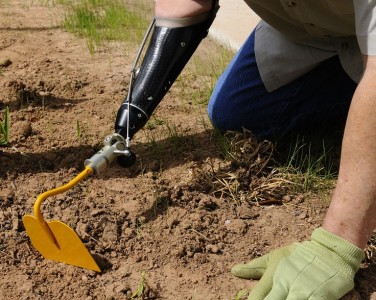At the end of a gardening session do you slowly rise to your feet, stretch, and feel the pains that toiling in the soil bring to your body? How many of us take the time to think about how the same activity level would affect a person with limited flexibility, one who is an amputee, or a person who is wheelchair bound? This summer I have been privileged to look at these issues from an up close and personal perspective. When we are young, bending, reaching, hauling heavy items, and kneeling are all commonplace and taken for granted. Through my work with combat veterans and family members who no longer possess these abilities I have begun to consider ways to make gardening a hobby that can be adapted for enjoyment at all ages and stages of life.
Elevated Raised Beds
Here in Alaska, raised beds are a natural choice for growing as they allow the soil to warm earlier than the soil in a traditional row garden. I was introduced to the idea of raising the boxes to a natural waist height by the book, “All New Square Foot Gardening” by Mel Bartholomew. By simply raising the height of the beds, and keeping to the four foot by four foot design model, it was found through studies done while researching for his book that this size bed size works for those with reach and bending issues. All studied were able to access all the way to the center of the garden. Further suggestions were made in his book that by adding wheels to the base of these higher boxes, they could be rolled indoors to allow the psychological benefits of gardening to be enjoyed by those who are bedridden. What a gift to those who otherwise would be precluded from such an enjoyable pastime. Since gardening in hospitals and nursing facilities that are air quality controlled may require special considerations to allow for patient respiratory health concerns, it is a simple question that can be posed to management to see if the introduction of plants and sterile soil would be allowed in patient rooms on a temporary therapeutic basis. If bedside gardening is not allowed, a plant potting session in common meeting areas with low allergen plants and sterile soil may be an allowable option. Just think of  the joy a few moments of playing in the soil could give a patient confined to an indoor facility.
the joy a few moments of playing in the soil could give a patient confined to an indoor facility.
In addition to the beds suggested by the square foot gardening method, there are other configurations that are suited to those in wheelchairs. Simply adapt the method by assessing the height and reach requirements and build boxes to suit.
Reach Extender Tools
Whether a person is gardening from a seated position, has difficulty bending, or is otherwise needing assistance with gardening tasks that seem to be just beyond their fingertips, gardening tools are available to extend a persons reach and aid in grasping, pulling, and digging. One such devise is the adaptive hoe shown here which is aiding in an amputee’s gardening pursuits.

As with any garden there will be lifting of soil, hauling of flats, and pouring of heavy water cans. With ingenuity and thought, wagons can be towed by wheel chairs or assist dogs, flats of transplants can be transferred on the basket of a walker or scooter, and heavy lifting can be done when necessary by more able aids, friends, or family.
When dealing with declining health and newly obtained disabilities, the initial human reactions to draw into ones self and withdraw from activities that would otherwise have been commonplace. I extend to you that it is our challenge to adapt and engage those who are in these situations so that their psychological well being can improve through the experience of tending a garden made specifically to suit their current abilities. If you are interested in the square foot gardening method I have mentioned for building tables, go to squarefootgardening.org for ideas and suggestions.
I encourage you in your pursuits to adapt to gardening in our fine State of Alaska, and to help to make Adaptive Gardening available to the large population who could grow in their gardening enjoyment through our efforts to adapt traditional gardening to meet their specific needs.
